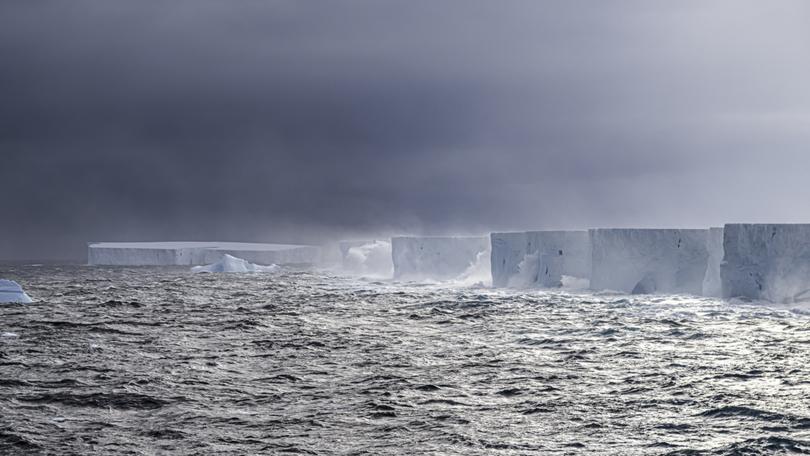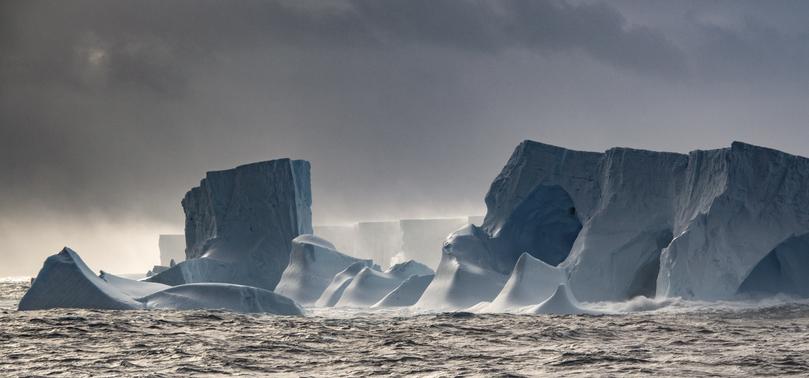World’s largest iceberg, A23a, is stuck spinning in circles after breaking free from Antarctic

For more than 30 years, the world’s largest iceberg was stuck in the Antarctic.
Five times the size of New York City’s land area and more than 300 meters deep, the mammoth piece of ice finally became loose in 2020 and began a slow drift towards the Southern Ocean.
Now, A23a, as it’s known, is spinning in place.
Sign up to The Nightly's newsletters.
Get the first look at the digital newspaper, curated daily stories and breaking headlines delivered to your inbox.
By continuing you agree to our Terms and Privacy Policy.After leaving Antarctic waters, the iceberg got stuck in a vortex over a seamount, or an underwater mountain.
Imagine a piece of ice about 3,900 square kilometres in area and as deep as the Empire State Building spinning slowly but steadily enough to fully rotate it on its head over the course of about 24 days.
The iceberg is spinning near the South Orkney Islands, about 600 kilometres northeast of the Antarctic Peninsula, and is “maintaining a chill 15-degree rotation per day,” the United Kingdom’s polar research institute British Antarctic Survey said on social media.
“It’s basically just sitting there, spinning around, and it will very slowly melt as long as it stays there,” said Alex Brearley, a physical oceanographer and head of the Open Oceans research group at the British Antarctic Survey.
“What we don’t know is how quickly it will actually come out of this.”
A23a has been embroiled in drama since the start, a trait it picked up from its parent berg.
A23, which was even bigger than A23a, was one of three icebergs that broke off, or calved, from the Filchner Ice Shelf in 1986.
At the time of the calving, A23 was home to a Soviet Union research centre and researchers eventually had to abandon the base.
A23a broke off later that year and hit bottom in the Weddell Sea, where it would remain for 34 more years.

In 2020, A23a finally freed itself, and in December, it began to move out of Antarctic waters on a long meander through the Southern Ocean. It took Mr Brearley and a research vessel almost an entire day to circle it during a visit in December. They were awestruck.
“It looks like land, that’s the only way to describe it,” Mr Brearley said.
But by spring, A23a caught the spins. Using satellite imagery, the British Antarctic Survey first observed the iceberg spinning in April.
Large Antarctic icebergs are designated by A, B, C and D depending on where in Antarctica they originate, and they receive a number only once they’ve reached a big enough size.
Their sequential order shows how long A23a has topped the list of the world’s biggest icebergs: A76 calved in 2021, for instance, but melted two years later.
The iceberg is in an area of the Southern Ocean known as Iceberg Alley, a popular spot for icebergs.
Typically, large icebergs move through quickly and get sucked into the Antarctic Circumpolar Current, the largest ocean current in the world.
The blocks of ice eventually get shot out eastward to warmer waters, where they begin to melt and disintegrate.
Mr Brearley described the transition as “a warm bath of water” only a couple of degrees above freezing.
Not A23a. Instead, the gigantic iceberg got caught in what’s known as a Taylor column, a current that forms around seamounts.
Standard flow diverges around the underwater mountain and creates a stagnant cylinder of fluids above the seamount, slowly rotating the water counterclockwise around the bump.
The bump A23a is swimming over is about 100 kilometres across (about 62 miles) and rises from the deep sea floor to a height of about 1,000 meters (3,280 feet), Mr Brearley said, calling it “a pretty cool geophysical phenomenon.”
How frequently these Taylor columns form or how often icebergs get stuck in them is not known, Mr Brearley said, and there is not enough satellite data or underwater mapping to fully understand the phenomenon’s frequency.
It’s also unclear how long the iceberg will stay in place. But one thing is clear: The largest iceberg in the world will not melt and flood the southern hemisphere. Melting icebergs and removal of floating ice shelves do not directly cause sea level rise, Mr Brearley said.
Mr Brearley pointed to a 2015 study that observed a robotic float, part of a fleet of instruments that drift in ocean currents to measure water temperature, trapped in a Taylor column for four years just to the northeast of A23a’s current location.
If A23a spends an extended time in the vortex, the iceberg could melt significantly and affect plankton and other organisms in the marine food chain in the area, Mr Brearley said.
Christopher A. Shuman, a glaciologist and research professor at the University of Maryland, Baltimore County, surmised that A23a would eventually go the way of other large icebergs — towards the island of South Georgia in the South Atlantic and melt.
He pointed to iceberg A68a, which in 2020 spun for months a little farther west from where A23a is now before being freed.
Whatever happens, “the margins of Antarctica” and their mysteries will continue to fascinate us, Mr Brearley said.
He noted a tagline used among glaciologists: What happens in Antarctica doesn’t stay in Antarctica.
“This is one of the ways that Antarctica reaches out to the rest of the world,” he said.
This article originally appeared in The New York Times.
© 2024 The New York Times Company
Originally published on The New York Times
